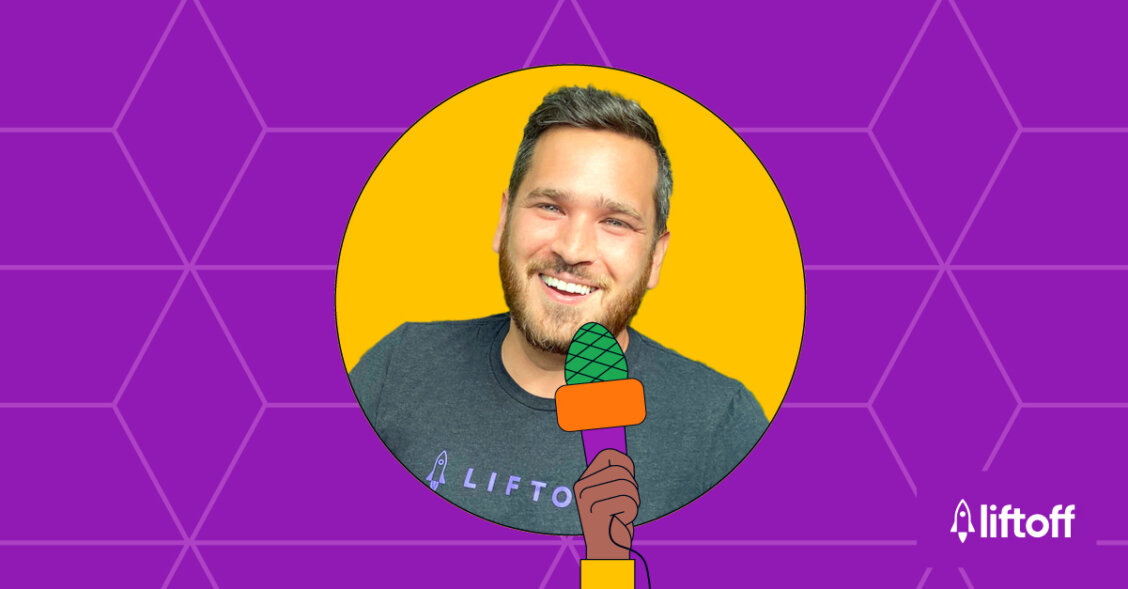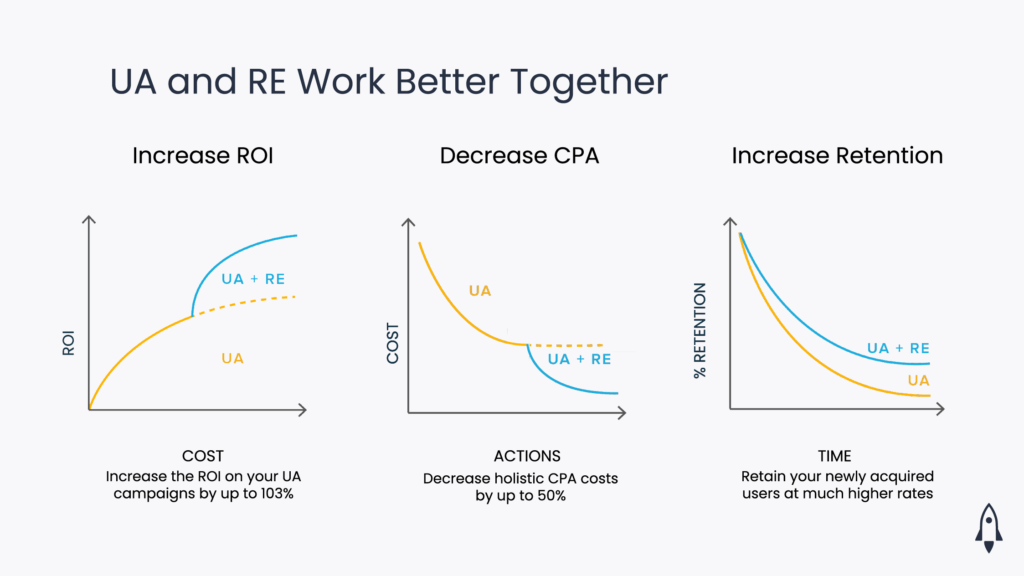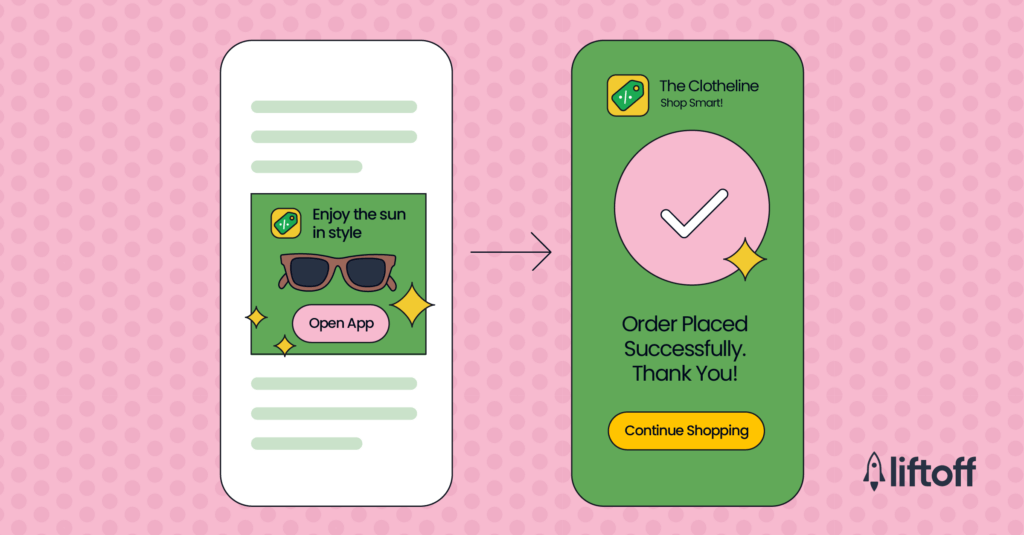
7 Mobile App Re-Engagement Best Practices Proven to Drive Results
Re-engagement still matters.
Despite the wave of privacy regulations set to limit the effectiveness of app performance marketing over the coming months and years, re-engagement remains an effective tool for mobile marketers today.
We chatted with Alex Dohrmann, Liftoff’s Senior Manager of Global Sales Engineering, to get the latest best practices on running successful mobile app re-engagement campaigns. Alex, a 15-year industry vet, has educated, consulted, implemented, and scaled re-engagement campaigns for Liftoff customers across every app vertical for the past five years.
On recommended audience sizes for re-engagement campaigns
“There’s some flexibility, but we aim for at least 250,000 device IDs per segment as a starting point. It’s not to say that you can’t find success with smaller audiences. We’ve run campaigns with as few as 10,000 users for high-value segments in casino gaming, where our casino gaming customers have isolated a group of big spenders they want to keep engaged (i.e., whales). It’s a very niche case. However, it’s a different story if you’re working with a finance app targeting registered users who have yet to take further action, like opening a checking account or applying for a home loan. In this case, trying to reach an audience of just 10,000 users takes a lot of work. You’d want a much larger audience because the entry barrier is already high, and the message can become stale over time, even with a rolling window of new users that fall into that segment over time.
“So the more challenging the event or goal, whether achieving a certain return on ad spend (ROAS) or revenue target, the larger the audience should be.”
On re-engaging user segments in the upper funnel to grow down-funnel engagement
“Think higher up the funnel. If you’re dealing with a segment that has taken one action but has yet to progress further, like registering for an account but not purchasing a subscription, you’ll want to improve engagement higher up the funnel. For instance, how many users created an account among an audience of 10,000 that installed the app in the past 30 days? You might find that only a small percentage did. Consider looking into intermediary events that are not currently tracked. It could be actions like page views or starting a registration process but not finishing it. You can then focus on bolstering these segments by tracking these additional events.
“More users will convert over time by filling the top of the funnel. If you don’t start with a sizable base, re-engaging users higher up in the funnel is often better.”
On testing re-engagement campaigns for incremental lift
“At Liftoff, we utilize two testing methods: PSA (public service announcement) and ghost bids. PSA is our preferred approach due to its specificity and the inclusion of a test and control group. Let’s illustrate how this works using a scenario where you’re targeting a segment of 500,000 past-paying users with a down-funnel CPA goal, aiming for additional purchases. Using the beginning of the Google Advertising ID (GAID) for segmentation, we’d assign 25% of those users to a control group where we display a PSA ad — an ad that lacks brand messaging, such as a Red Cross ad. The remaining 75% would be exposed to general re-engagement messaging, encouraging them to make another purchase in the app.
“It’s important to note that for the control group, we are primarily interested in tracking the organic behavior of those users. By showing a PSA ad, we can use the attribution window data related to user engagement, such as viewing the ad or potentially clicking it and any subsequent action like donating. We’re keen on understanding if they return to the app and make additional purchases without seeing a re-engagement ad.
“For the test group, we serve them a message about the marketer, and we can monitor their behavior as well. The metrics we focus on depend on the customer’s KPIs. Are they interested in ROAS, CPA, or something else? We have various ways to measure this, including assessing incremental ROAS or applying multipliers to the number of events for incremental lift.
“In most cases, we simply evaluate incremental profit or lift against those events. Re-engagement campaigns lend themselves well to this kind of analysis because it’s straightforward. You’re targeting a defined list of users within a specific segment with a standard. We can also compare ads served versus the organic behavior of an advertiser’s users.”
On avoiding cannibalization when running re-engagement campaigns
“It depends on the desired event a marketer tries to drive in their app. If it’s just installs, there are better approaches than re-engagement. But if it’s registration, advertisers should gather data from their MMP about the average time a user takes to complete that event after installing. Do most users complete the event within a few hours or a couple of days? Liftoff can also analyze our attributed data from UA campaigns to find this answer. For example, suppose the marketer is running UA with Liftoff. In that case, we can see that, on average, 90% of users complete the registration event three days after install.
“Based on this, we’d recommend not retargeting users within three days of install to allow room for these users that came through organic or paid UA to register potentially. And we would institute a blockout window of three days from the point of install to avoid user cannibalization. We could extend the blockout window to four days for added safety.
“Another consideration is avoiding cannibalization among re-engagement partners or partners running the same segments. One way to prevent cannibalization across re-engagement partners is to segment device ID lists within a given audience.
“For instance, dividing Android devices based on the hexadecimal system (each device starts with zero through nine or A through F). A partner could provide Liftoff with a list of device IDs that begin with zero through six, a second re-engagement partner with seven through B, and a third partner with C through F. This technique would avoid user cannibalization within one audience segment across re-engagement partners.”
On reducing conversion friction with deep-linking
“Deep linking is a process where we append an app scheme within the click tracker, meaning the user will be taken directly to the app if they already have it on their phone, rather than redirecting them to the app store. The less friction there is for users to enter the app, the better the re-engagement user experience.
“Deep linking can get quite technical. An app scheme can be auto-embedded via universal links in the customer’s click tracker. This behavior is automatically included in the app’s SDK with the customer’s MMP. For instance, if a customer provides us with a universal link, it’s usually included in the redirect. Given the complexity, customers should collaborate with Liftoff or the MMP. This ensures that deep linking functions properly, reducing user friction when entering the app directly from the ad experience.”
On how re-engagement campaigns decrease UA campaign costs
“When re-engaging users, you could prevent them from dropping out of the funnel. By reminding them about your app, there’s potential to retain these users well before they churn.

“The diagram above demonstrates how UA efforts enhance return on investment because user numbers and costs increase over time rather than just plateauing. You decrease CPA costs because the cost per acquisition decreases over time. Additionally, you boost retention, the biggest aspect of the equation. Many apps lose around 90% of their user base within the first 30 days after install. So maintaining engagement with users before they have the chance to churn positively impacts getting more users to complete more actions higher in the funnel, increasing completed actions lower in the funnel over time.”
On why re-engagement campaign goals are more aggressive than UA
“When you think about re-engagement, it’s common for CPA goals to be more ambitious than UA. For example, a customer may set a CPA goal for the first purchase for their UA campaign. For a re-engagement campaign, the customer may set a CPA at $3-$3.50. The rationale here is that users already have the app and have demonstrated some level of engagement. So, having the app installed already makes users more likely to purchase. It would make sense then that, viewed holistically, combined UA and re-engagement efforts lead to an overall reduction in CPA costs. Even if you just take the average CPA costs for UA and re-engagement individually, the result for re-engagement should be lower, given the user’s higher propensity for achieving the desired action.”
